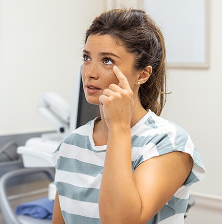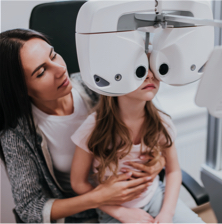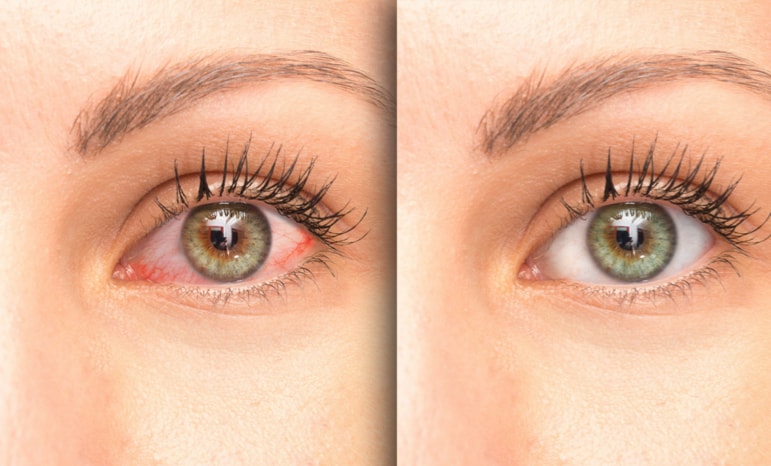
- Cambridge, ON
- (519) 624-2020

Dry Eye Clinic in Cambridge
REQUEST YOUR APPOINTMENTDrive Away Your Dry Eye Disease
Our eyes are necessary for practically everything we do. From computers to construction sites, dry eye disease can affect our ability to perform our jobs, whatever they may be. Even our hobbies can be affected by dry eye. Approximately 1 in every 5 adults suffers from the condition, and while it is usually mild, if left untreated it can lead to more serious conditions.
You do not need to suffer from dry eye. We can help you keep your eyes feeling great and also give you the knowledge you need to manage any possible future issues.
Request an appointment and we can help with the rest!
Are you suffering from dry eye? Take our online assessment to find out.


Dry Eye Symptoms

People with dry eye disease may experience:
- Overly watery, teary eyes
- Stringy mucus in the eyes
- Redness, itchiness, and irritation
- Difficulty wearing contacts
- Eye fatigue
- Light sensitivity
- Blurred vision
If you are experiencing any of these symptoms, request your appointment to discuss dry eye therapy today.
Dry Eye Risk Factors
No two dry eye cases are ever the same, and your optometrist will work with you to find the cause and right strategy to help manage your symptoms. However, there is an abundance of risk factors that can play a role in the development of dry eye. They may include:
- Ageing
- Diseases like blepharitis
- Medical conditions including diabetes, thyroid disorders, Sjogren’s syndrome, or vitamin A deficiency
- Tear gland inflammation
- Laser eye surgery side effects (though these are normal and usually resolve a few weeks to months after the procedure)
- Medications used for birth control, high blood pressure, Parkinson’s disease, and acne
- Meibomian gland dysfunction (MGD)
If you think you may be at risk for dry eye disease, request an appointment today.
What Is Dry Eye Disease?
There are two main types of dry eye disease—aqueous deficiency and evaporative dry eye.
If you have aqueous deficiency, your eyes do not produce enough tears to keep themselves moist and comfortable. Aqueous deficiency dry eye accounts for only about 10% of all dry eye cases. It is far more common to have evaporative dry eye, the type that results from an imbalance in the tear film.
The precise chemical makeup of your tears is very important. When the tear film is out of balance, tears tend to be of poor quality, and dry eye is often the result.
Three different layers make up the tear film: a mucus layer, a water layer, and an oil layer.
The mucus layer helps keep the tear on the surface of the eye, the oil layer prevents the tear from evaporating too quickly, and the water layer provides hydration.
The tear film protects the surface of the eye from microbes and
helps you see clearly. Its dynamic nature is the reason that contact lenses are able to be worn, allowing for convenient vision correction.
If any of the tear film’s 3 layers are out of balance, you may experience dry eye. To learn more about dry eye, request an appointment with one of our optometrists.
Meibomian Gland Dysfunction & Blepharitis
The meibomian glands are the tiny, oil-producing glands located along your eyelids. If they are not producing enough oil, meibomian gland dysfunction (MGD) or blepharitis may be the cause.
Inflammation in and around the eyelids can cause blepharitis. This condition presents as sore, red eyelids with crusty eyelashes.
Practising good eyelid hygiene is essential to managing blepharitis. When debris and bacteria accumulate along the eyelid margin, it creates an environment where mites can feed. The mites increase in numbers and more eyelid inflammation results.
The meibomian glands can become blocked as a result of too much inflammation. Blocked meibomian glands mean that your tear film may be lacking in oil, causing the water layer of your tears to evaporate too quickly, before your eyes have been properly moisturized.
Dry eyes and blepharitis occur alongside one another frequently, so targeting the inflammation can get to the root of what is actually causing your dry eye. If you notice red eyelids, crusty eyelashes, or dry eye symptoms, it’s time to request an appointment for a dry eye diagnostic.
Our Detailed Diagnostics
Our optometrists take the time to get to know you and your unique situation. We will perform a thorough assessment of ocular health, ask questions about your lifestyle, and get to the root cause of your dry eye.
Often, there are multiple factors at play that lead to dry eye. A combination of medications, health history, environmental conditions, and genetics can result in a less-than-comfortable vision situation.
Learn more about our diagnostic methods.
Meibography is an imaging study used to detect symptoms of MGD. Though it can’t help directly treat the problem, it can give your optometrist insight into the structure of your meibomian glands, and how well they are working. With this information, your optometrist can help create a suitable management plan.
Osmolarity is a diagnostic test of your tears to help determine the cause of any tear film imbalance and the severity of your dry eye disease. The information found can help your optometrist come up with a management plan to restore balance to your tear film.
Our Treatment Methods
If you are experiencing any of the uncomfortable symptoms associated with dry eye disease, we can help. Relief is available!
Our office has invested in innovative treatment methods to help you get back to clear, comfortable vision. After an assessment and dry eye diagnosis, we will thoroughly explain your treatment options and recommend the best course of action for your unique situation.
Learn more about the treatment methods we offer at Cambridge Eye Care.
Intense pulsed light therapy (IPL) is an effective non-invasive treatment to alleviate dry eye symptoms. The device uses light energy to target specific areas of the skin around the eyes to reduce inflammation. This allows the meibomian glands to produce more oil to lubricate the eyes and reduce the uncomfortable effects of dry eyes.
Radiofrequency (RF) is a non-surgical treatment for dry eye. The device delivers a high-frequency electrical current to the skin to generate heat and help melt the thick oil secretions clogging the meibomian gland. More oil means the quality of your tears improves. RF can also reduce inflammation around your eyes that could be contributing to your dry eye symptoms.
Meibomian gland expression is a therapeutic technique used by your optometrist to help clear blockages in your meibomian glands, usually caused by MGD. The treatment applies therapeutic heat and pressure on the meibomian glands.
- Artificial tears – provides added moisture with the same elements your natural tears have. We are happy to walk you through the available options and recommend a brand unique to your needs.
- Hot compress – the heat helps open up the meibomian glands to improve oil gland function and slow down tear evaporation.
- Hypochlorous acid spray – an effective treatment against bacteria and can contribute to better eyelid hygiene.
- Blephadex wipes – a gentle, non-abrasive way to clean, soothe, and moisturize for your eyelids.
- Vitamin Supplements – omega-3 fatty acids can help to decrease inflammation and improve the function of the meibomian gland to increase the oil in your tears.
In-Office Treatments
Buy Dry Eye Products

Blephadex Eyelid Wipes
These all-natural wipes are designed to make your eyelids feel soft and moisturized. They are individually packaged and great for on-the-go.
Learn More
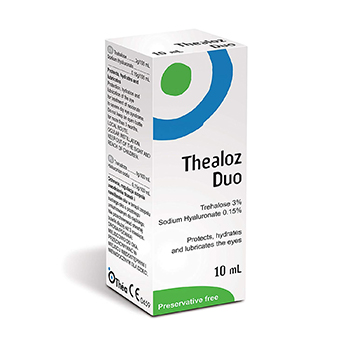
ThealozDuo
Thealoz Duo provides lubrication and promotes regeneration of the eye’s surface. It is a preservative-free product that can be used by contact lens wearers. Thealoz Duo offers long-lasting relief from moderate to severe dry eye.
Learn More
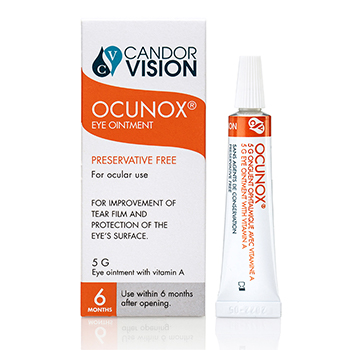
Ocunox
Ocunox is an ointment that improves the tear film and protects the surface of the eye. It is preservative- and phosphate-free and designed to be used overnight. The product contains Vitamin A, helping it integrate with your current tears.
Learn More

Hylo Gel
Hylo Gel offers strong and long-lasting dry eye relief. It is developed for patients with severe, persistent dry eye. It is preservative- and phosphate-free and will not cause blurred vision when applied.
Learn More
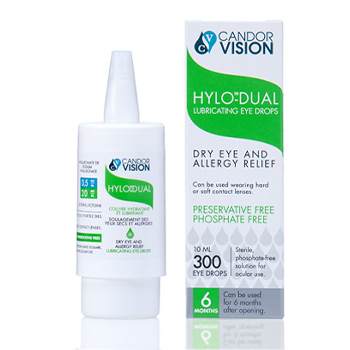
Hylo Dual
Hylo Dual are artificial tears designed for those with allergy-related dry eye. They provide long-lasting dry eye relief while protecting the eyes from further irritation. These drops are preservative- and phosphate-free and are also suitable for contact lens wearers.
Learn More
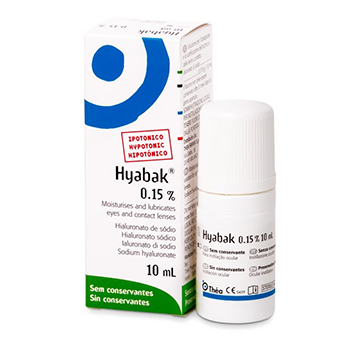
Hyabak
Hyabak is a preservative-free eye drop that contains sodium hyaluronate as an active ingredient. They provide long-lasting relief for mild to moderate dry eye by retaining water and releasing it progressively and intuitively.
Learn More
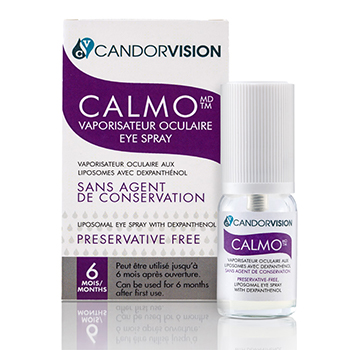
Calmo Eye Spray
Calmo eye spray offers immediate comfort when sprayed on the closed eye. It stabilizes the oil layer of the tear film. This is an excellent option for people who do not want to apply eye drops.
Learn More
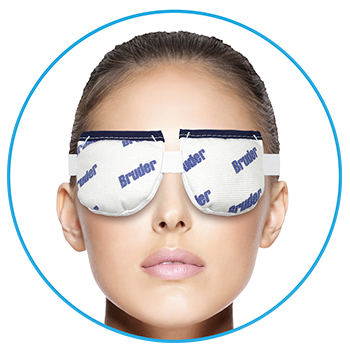
Bruder Mask
This mask is a moist heat eye compress that opens the oil glands in the eyelids. To use, simply microwave the mask for 20-25 seconds and then apply to the eye area for 10 minutes. Safe for frequent use, it is also self-hydrating, washable, and reusable.
Learn More
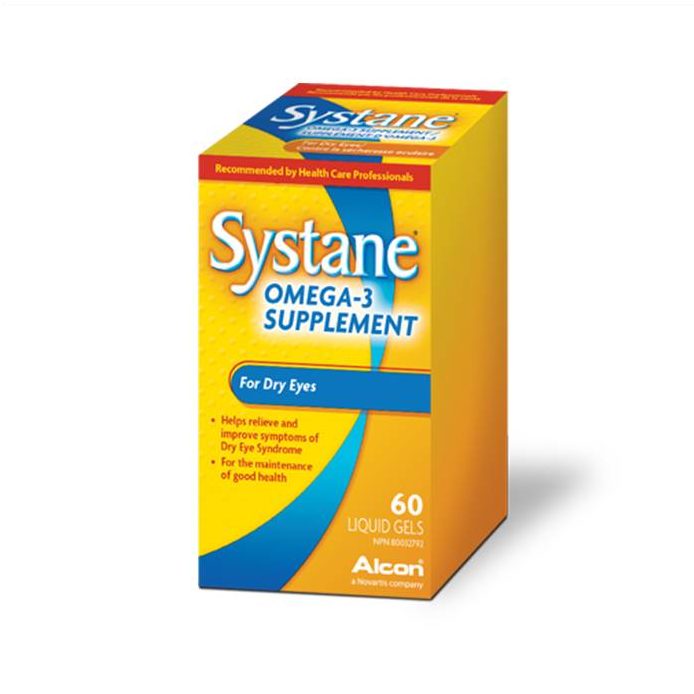
Systane Omega-3
A source of omega-3 fatty acids for the maintenance of good health. Helps relieve and improve symptoms of Dry Eye Syndrome. Helps support proper tear function. Also supports cognitive health, brain function, and cardiovascular health. Helps to reduce serum triglycerides/ triacylglycerols.
Learn More
Our Reviews
It’s always great! Love the doctor and all the people that work there! Very patient and helpful.
Noemia F
Staff are great there! It’s a bustling place, but they’re well organized and always have a smile and positive customer service. Optometrists are very knowledgeable and helpful.
Alexandra P
I went there today to get some new glasses. There was no wait, as I was seen at 2:55, even though my appointment was for 3:00! The staff were exceptionally nice and the optometrist I saw was extremely pleasant and knowledgeable. The location is beautiful and they have a great selection of glasses frames. I was very impressed with my visit.
Andy T
Where to Find Us
You can easily find our office at the Canamera Medical Centre, located South of Zehrs at Cambridge Centre. We have free parking, with convenient handicap parking right in front of our office. Visit us today!

Our Address
350 Conestoga BlvdCambridge, ON N1R 7L7, Unit C3
Hours
Our Services
Our Brands




Our Awards
Optometry Services

Optical Services








